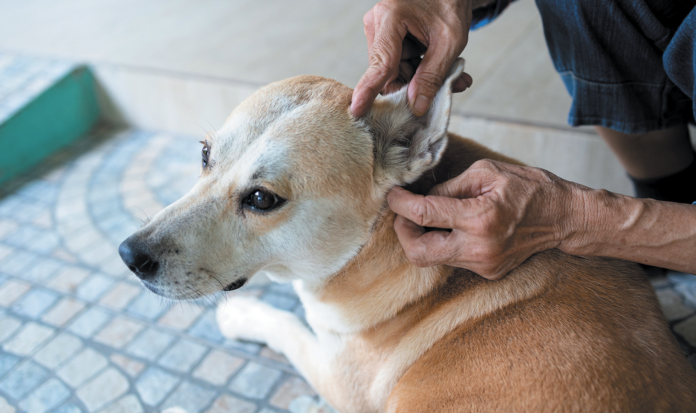Your dog’s veterinary exams occur but once or twice a year. But you can give your pet physical exams at home to see if there might be a reason she should be brought to the doctor between scheduled appointments. Take these seven steps to assess your dog’s health, many of which are also recommended by the Humane Society of the United States. You don’t have to do them every x number of days or every y number of months. They’re just little checks that you can periodically slip into your moments of physical closeness with her.
Look over your dog’s skin. As you pet your feline, feel for lumps, scratches, scabs, swelling, or other things that seem “off.” A scratch or scab will probably self-resolve, but a lump or swelling should be brought to the attention of a veterinarian. While you’re looking, part your pet’s fur to look for fleas. Little black specks —“flea dirt”— are the telltale sign and an indication that your dog needs to be treated. An unkempt coat or bald areas may also indicate illness.
Have a peek at the ears. The ears should be clean and odorless. Along with a foul odor, check for flaking, scabs, or discharge. If you see a gritty, black discharge, especially in conjunction with severe itching on your dog’s part, it could be ear mites — parasites that not only cause discomfort but are also contagious to other dogs, including dogs in the household.
Eye clarity. The eyes are a prominent part of a dog’s face; you’ll probably notice something is amiss even if you don’t make a conscious effort to look for it. If there’s redness, discoloration, discharge, squinting, or the emergence of the third eyelid, take your dog to the vet. Unless the eyes are clear, bright, and focused, there’s a good chance there’s a problem that needs medical intervention.
Check the mouth. The gums normally should be pink. If the gums are dark red or white, on the other hand, something may be wrong. And if your dog’s breath makes you want to back up a step or two, it’s time for a dental visit. Your pet’s breath isn’t going to smell minty fresh, but neither should it make you recoil.
Nose around. Mucus or other discharge from the nostrils is not normal and should prompt a veterinary visit. Ditto if you see your dog frequently pawing at her nose or sneezing a lot. But whether the nose is cold or warm doesn’t tell a thing. Both are acceptable depending on a dog’s activity level and the ambient temperature.
In with four feet. While some dogs don’t like having their feet handled, it’s good once in a while to make sure your pet doesn’t have torn claws or cuts (which could be painful), or swelling or other signs of infection. Trim claws that are too long, avoiding the pain-sensitive bundle of nerves and blood vessels (the quick) by clipping just the nail tips and going no further.
Eyeball your pet’s weight. If your dog is looking thinner and you are not feeding her any different-ly, that’s a sign that something could be amiss with her metabolism. You definitely want to have that checked out by the vet. Conversely, being overweight will shorten your pet’s life and is also cause for a discussion with
your veterinarian.






I love Your Dog newsletter!!!!! I have had a pet care business for 21yrs. I get 4 dog magazines and 3 dog/animal newsletters. I love to read all of the tremendously valuable and educational information. I always, always, always learn something new as well as things to share with my clients. Your Dog is one of my favorites!!! I will print the above article “7 Step Assessment of your Dog’s Physical Health” to share with my clients. It is short, concise, simple, specific and so easy to understand. I really like the layout and presentation of the newsletter. As soon as I get it, I scan the bold print to see the topics of the articles and then I look forward to what I am going to read and learn. Thank you for such a great publication!!!!!